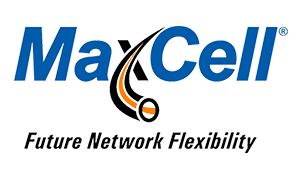

SPONSORED
Flexible Fabric Innerduct Assists with Network Construction Project
By MaxCell | January 12, 2024
Read Time: 4 Minutes
A new airport facility and adjoining concourse was recently completed in a major Midwest city and was the largest single infrastructure project in the city’s history. With electric vehicle charging stations, an array of smart building systems, and world-class IT technology, the build was certified LEED® Gold and will serve the region for decades.
Challenge
Although the terminal/concourse facility was all new construction, the underground fiber infrastructure had to be tied to older existing buildings, including the airport command center (police and security), fire station, and administration building. These buildings had a mix of existing 4” older hardshell innerduct and some newer conduit.
The administration building was several blocks from the new facility, meaning it was a considerable distance from the two Main Distribution Frames that provided the primary hub or demarcation point that interconnects the IT and telecommunications lines into any of the buildings.
Solution
One of the goals of this new facility was to build extra capacity in the network infrastructure’s fiber backbone so that when demand increases, there’s no need for extensive reconstruction to scale up. The flexible fabric innerduct from MaxCell® was chosen as a cost-effective solution to provide capacity for future expansion needs for a number of reasons, including:
- Reduces the number of conduits required for new network construction
- Minimizes the need for additional conduit in overlay applications
- Enables incremental deployment to match system requirements
The Project
One of the largest and most respected union electrical contractors in the Midwest who specializes in the design, installation, and maintenance of complex electrical systems was responsible for the installation of the flexible fabric innerduct from MaxCell.
The general foreman, a Registered Communications Distribution Designer (RCDD) for the electrical contractor, provided further information on their experience in using MaxCell in this project.
This installation utilized over 30,000 feet of the MaxCell flexible fabric innerduct/ Because the contractor’s team had not used this product before, they arranged for MaxCell to come to their facility and provide pre-install, hands-on training to their crew. Their installers were pleased to find how simple it was to pull and install using swivels specifically designed for underground cable-pulling applications. They were able to load the three reels (10,000 feet each) onto their large reel truck for the installation.
In talking about what they experienced with this product, the general foreman said their crew commented not only on the ease of use but also that it was much less labor-intensive to install and was less of an overall physical strain on them.
Because of the need for extreme durability without forfeiting conductivity, indoor/outdoor armored cable was specified throughout this project. This provided better protection against physical and environmental conditions and no transition was needed between the indoor/outdoor phases of the installation.
The downside to this cable type is that it can be relatively sticky. Their crew found that the cable pulled through the MaxCell flexible fabric innerduct went quickly and efficiently. In contrast, cable pulled through some of the older HDPE rigid innerducts was much more labor-intensive and time-consuming. In comparison, the MaxCell installation was done in less than half of the time it took the crew installing the cable through the older HDPE innerduct.
He also said that the MaxCell product provided maximum efficiency where space was limited or bends were needed. This was especially important in the cable runs to the existing outlying buildings.
Summary
This project had unique challenges in terms of laying the fiber and copper cable in the facilities and was a complex engineering task. MaxCell proved to be a valuable asset to the project.
Benefits recognized from using MaxCell:
- Helps expand capacity
- Preserves space for future bandwidth requirements
- Reduces total project costs
- Reduces wasted space compared to rigid innerduct
- Installs 2X faster than traditional innerduct
Designed specifically for the network construction industry, the enhanced efficiency of MaxCell’s flexible fabric innerduct over traditional rigid innerduct makes it a perfect solution for almost any project.

ABOUT THE SPONSOR
This article was brought to you in partnership with MaxCell.
With 20 years of industry-leading technology, MaxCell® is one of the fastest-growing products in the network construction industry. Accepted by the USDA's Rural Utilities Service (RUS) and installed by the largest global telecommunications companies, cable MSOs, and Fortune 500 companies, MaxCell has become the standard for allowing companies to maximize their conduit space while reducing total system costs. MaxCell is the only flexible fabric innerduct system designed specifically for the network construction industry.



